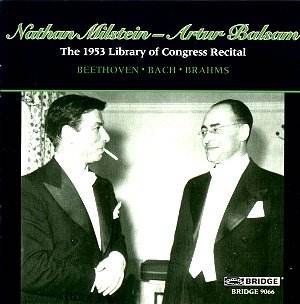This is a companion to the earlier 1946 Milstein-Blatt
Library of Congress recital on Bridge 9064. Though recorded seven years
later the sound is in some ways poorer than that earlier recital, even
though the 1946 acetates were afflicted with hum and scuffs. In 1953
the sound is rather recessed and cramped with Milstein’s tone given
an acerbic edge and Balsam emerging, probably unfairly, clangourous.
Despite this however admirers will find little to complain of, given
the high level of interpretative skill on view, the increased equality
of relationship in the partnership between violinist and pianist and
the satisfactory programme. This differs markedly from the Old School
1946 recital, a heady mix of Baroque-Romantic-Sweetmeat confection,
with the piano-accompanied Mendelssohn Concerto taking centre stage.
By 1953 Milstein was playing a solid trio of masterworks with its central
panel one of his great strengths, a Bach Partita, the D Minor with the
concluding Chaconne.
As adjuncts to his discography this trio makes compelling
listening. He had recorded the Spring with Balsam for RCA three
years earlier and was to record it again a few years later, in 1958,
with Rudolf Firkušný for Capitol/EMI. Meanwhile other performances
have emerged – a live 1957 performance again with Balsam, with whom
he had earlier made an unpublished 1947 attempt for Columbia. This Library
of Congress performance opens in surprisingly sunny fashion before sweeping
and perhaps a trifle-overheated passagework drives the first movement
onwards. The adagio has, as excellent sleeve annotator Harris Goldsmith
notes, a flexible momentum whilst being in no sense indifferent to the
lyrical beauty of the movement though whether the duo’s ensemble in
the Scherzo justifies the words "awe-inspiring" is perhaps
a matter of taste. The vigorous engagement of the finale can’t though
be gainsaid; Milstein’s almost exact contemporary Balsam living up to
his reputation as a sterling chamber collaborator.
The Brahms D Minor is famous from Milstein’s 1950
recording for RCA Victor with his long-time colleague and friend Horowitz.
Horowitz was a maddeningly bad Brahms player and this was an inconsistent
performance surpassed on balance by this later live recording. I still
find points of contention here. Harris Goldsmith admires Balsam’s pianism
– his use of the sustaining pedal, expansive phrasing and idiomatic
sonorities – but I find him less convincing. His rubato is to my ears
disruptive, the stresses and caesurae he imposes impeding to the flow
of the first movement in particular, allied to which Milstein’s propulsive
tendencies are sometimes overwhelming. The gains of a live performance
are sometimes counterbalanced here by structural flaws - it’s true that
in passagework Balsam is more obviously pliant than Milstein but I find
the rhythmic liabilities too great. There’s certainly nothing analogous
to the playing of Szigeti and Petri in their recording of this work,
one of the greatest ever committed to disc. There are some glorious
moments in the slow movement – and one or two expressively gulped notes
from the violinist – but the phrasing never quite seems as seamlessly
right as it does with Szigeti. The finale is bold and slashing with
both Balsam and Milstein on truly combustible form, the performance
taking off – a little late for me – with real drama. Nevertheless despite
the caveats this is a must-hear performance for Milstein admirers who
will find much to savour.
The Bach is a performance on a higher plane altogether.
Three commercial recordings exist – two from integral sets of the complete
Partitas and Sonatas in the 1950s and 1970s; the other was a pre-war
Columbia recording. Here is Milstein at his 1950s best. Technique is
allied to expressive nuance harnessed to control and intellectual insight.
In the Sarabande for example the sense of motion is controlled by the
most subtle and flexible of rhythms, his performance energized still
further by the exigencies of a live performance. In the Chaconne he
is sonorous if with very slightly intrusively sentimentalized tone on
the lower strings. The recording still makes his E string sound acerbic
and rather tart but the pauses, fluctuations and expressive devices
he utilizes are all deeply impressive. Clarity of passagework and aristocracy
of conception inform his every move; there is not the triumphalist conclusion
at the end, rather a steady, almost abstract exploration of the curve
and return of the line. If the conclusion is not overwhelming – and
in the crude sense it is not – then it is still one of majestic understanding
and control. Not only was he probably the best of the putative Auer
pupils as a chamber player, but also certainly the greatest Bach player
of them all.
Strongly recommended then, distant and abrasive recording
notwithstanding. Along with the earlier Bridge recital, from 1946, Milstein
is caught in his mature glory, inconsistent maybe in places, but always
unignorable and a beacon of sanity, insight and command.
Jonathan Woolf


